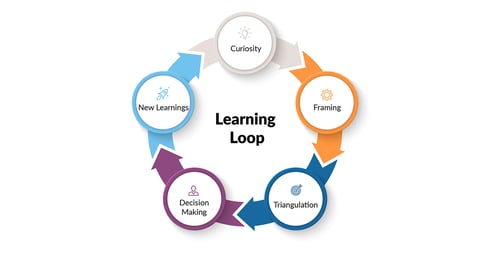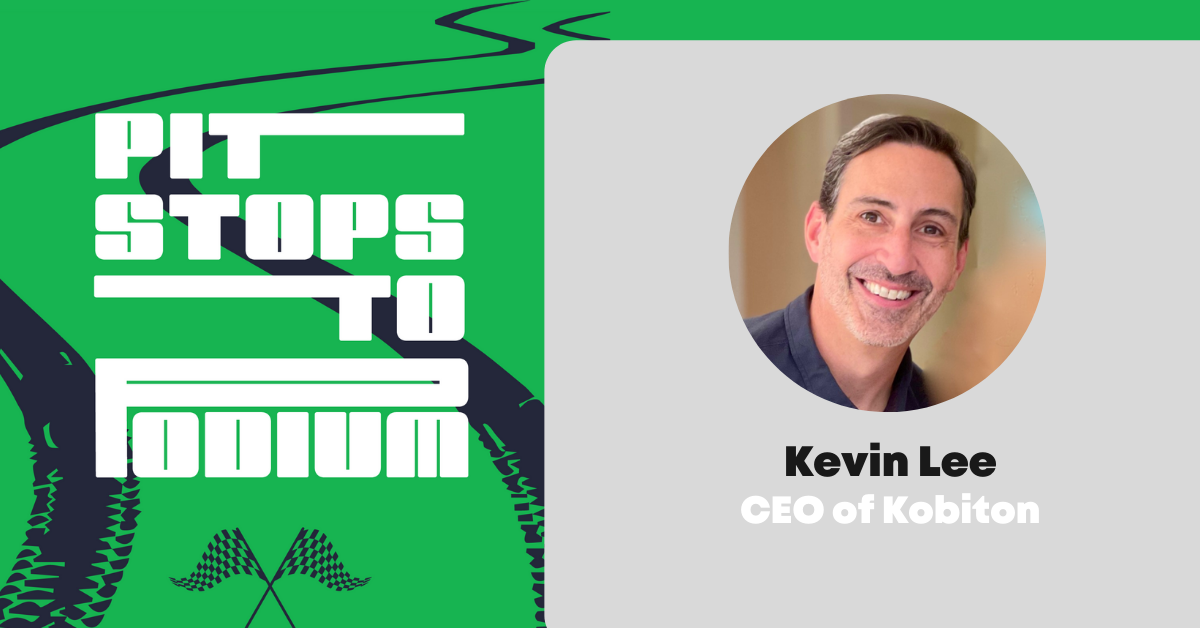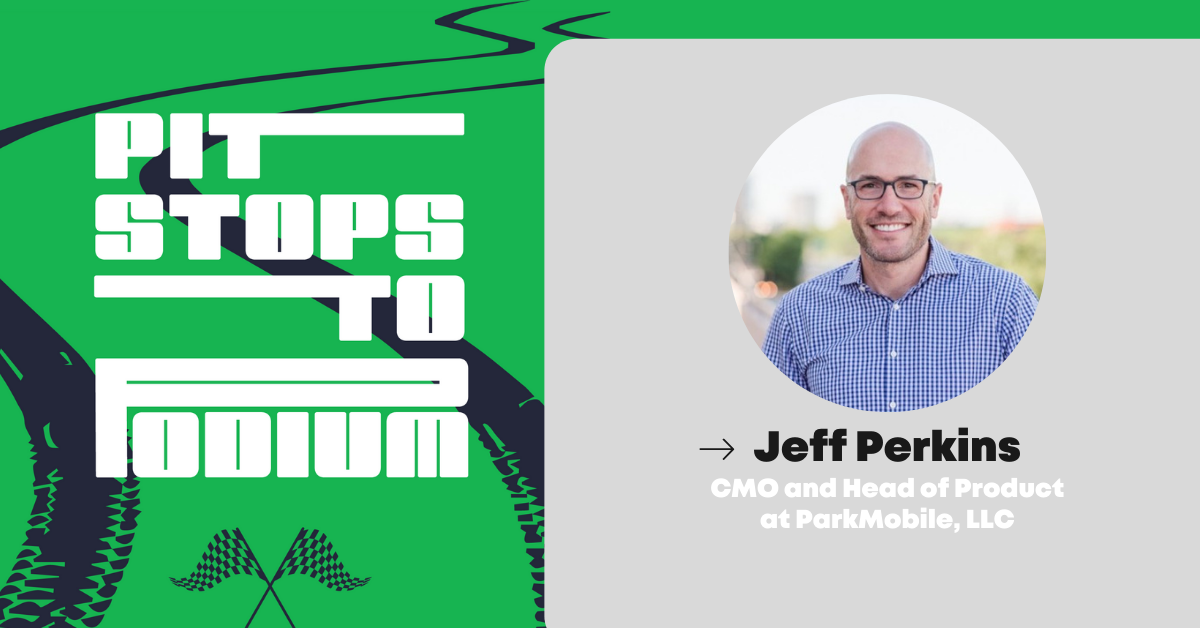Table of Contents
Along the entrepreneur’s journey, a habit of continuous learning develops into what "Crew Chief" Matt McIlwain has coined "The Learning Loop." Partnering with talented founders and innovators for over twenty years, Matt has seen patterns develop as entrepreneur’s experiment with new ideas and begin to scale their companies. Currently the Managing Director @ Madrona Venture Group, one of the top VC firms in the country, he holds the unique perspective as an operator while also connecting with entrepreneurs in the technology space.
One Lap Around The Loop
 Stay Humble; Stay Curious: "The cycle of learning starts with your genuine curiosity...admitting that you don't know the answer. That really is an act of humility. Sounds like: "I don't know."
Stay Humble; Stay Curious: "The cycle of learning starts with your genuine curiosity...admitting that you don't know the answer. That really is an act of humility. Sounds like: "I don't know."
⬇
Focused Framework: "Focus around a core question or problem you are passionate to solve for a specific type of customer...Develop these hypotheses, test them, and learn from all the data that you get back." Looks like: Sunny Gupta from Apptio
⬇
Artful Triangulation: "You're going to have disagreements in the data and disagreements in the perspectives that you get...Take all that data, bring it in, and test it against your intuition." Looks like: Amazon and Smartsheet
⬇
Time to Decide! "You can't just be in triangulations-land forever....get some empirical feedback. Decision making leads to action and any kind of good decision and experimentation process leads to new data." Sounds like: "Ok, we're going to try something."
⬇
New Learnings: "This is an agile process. New learnings allow you to make the next set of adjustments, ask the next set of questions, and then go around the loop again." Looks like: Asking more questions. Staying humble. Staying curious.
More From Matt McIlwain
Read further insights on the Leaning Loop and other topics on the Madrona Insights page.
You can connect with Matt by email: matt@madrona.com
Full Transcript
BT: Hey everybody, Welcome to Pit Stops the Podium, the RevPartners' podcast where we talk to executives who have competed and won, taking their companies from high growth to high scale. My name is Bernard tolleson. I am the co-founder and CEO of partners. And I'm excited to announce my guest today is Matt McClain. Welcome Matt.
MM Thanks for having me.
BT: Well, I'm not going to force you to give a background. I think that's makes people a little uncomfortable. So I will do that for you. Matt is currently serves as a managing director at Madrona, one of the top VC firms in the country around technology Prior to being at Madrona, Matt was with Genuine Parts and serving in a VPPA business process role, publicly traded company. So, one of the benefits of having Matt with us today is he has this unique perspective where he's only served as an operator, but also has been able to partner alongside some of the top entrepreneurs in the country. So, having his perspective for our audience is a true delight. Thank you, Matt.
MM: Well, it's very kind introduction. Thanks so much.
BT: Well, Matt, before we give you a big idea, one of our traditions here at the podium is to get to know our guests. And so let me go through some rapid fire so that our audience can get to know you a little bit better. So, you are living in the Northwest, if I recall you enjoy the outdoors. So, what is your favorite outdoor activity?
MM: Oh, my favorite outdoor activity. Skiing. I just love skiing and Western ski slopes are a little bit more powders; lots of fun.
BT: That's great. Favorite sports team.
MM: That's easy. Seattle Seahawks, we're hoping we'll get another chance at a Super Bowl this year.
BT: I'm a Falcons fan. But I, so I can tell you, I live in misery and Super Bowls where you blow a 28 to 3 or throw an interception on the goal line right at the end of the Super Bowl.
MM: I think it was the same team, unfortunately, that we lost there.
BT: Yeah, we have a common enemy. So, what's your favorite nonprofit.
MM: Oh, gosh, that's really hard. But I would say the Fred Hutch Cancer Research Center in Seattle, which have been on the board for many years, and they're just doing incredible work at the intersections of all the technologies that we love and biology and chemistry.
BT: That's great. And the last question isn't really a fair question, but favorite school. If you had to pick Dartmouth or Harvard, which way you're going to go?
MM: Oh, your college is always your Alma mater that you love the most. The Dartmouth college, for sure.
BT: Excellent! Well, thanks for going through the rapid fire. Now, let's transition into the big idea. So, as I mentioned earlier in the introduction, you've had this unique seat where you've been able to walk alongside some of the top entrepreneurs in the technology space, and you've coined this phrase or this term, the learning loop. And so I'd love to spend some time understanding what you mean by that entrepreneur's journey with the learning loop. So, let's start first with how you define it. And then let's walk through the process.
MM: Well, sure, so the learning loop is a think of it as a circle. It's a cycle of learning that starts with your genuine curiosity. And we'll get more into that. It's really from way back early in my career. I was in the management consulting world and then, as you mentioned, in the operating world, and it was at a time of a lot of disruption in the operating world. And so we really had to be asking questions and be curious about what was going to stay the same. And what was going to change. And then, of course, over the last 20 years as a venture capitalist helping build companies from day one, there's been countless opportunities to refine this model, this circle of moving from curiosity into learning. And then looping back around into the next questions that you need to ask.
BT: That's great. So let's dive into a little bit of that framework, so if I recall, there are five different kind of spokes on that wheel, or if you want to use that kind of terminology. So you mentioned the curiosity, framing, triangulation, decision making, and new learning. Let's dive into curiosity and then we'll move into the next category.
MM: Well, one of the things I love about curiosity is that it's admitting that you don't know the answer. And that really is an act of humility. To say, I don't know, I need to learn more, I need to ask the question and not just ask the question, but genuinely listen. And one of the things that we found is that they are the most successful entrepreneurs are ones that are willing to do that. They might have a hypothesis. Right? But they know that they need to go ask questions. And most importantly, ask questions of those people that they think are going to be the customers. And not to get too far down the path, but there's both the customer who's the user, and there's the customer that's the buyer. And sometimes those are the same customer and sometimes they're different. But it does start with that genuine humility and curiosity, which then leads into the next area of framing.
BT: Now, that's interesting, typically, that's kind of counterintuitive. You would think with entrepreneurs that they're expected to know everything. And if they don't know it, fake it. And what you're saying is it's OK to actually acknowledge you don't know. All right. So let's go to the next one in terms of framing.
MM: Right so when you do have, in fact, this genuine curiosity, you should come in with some kind of hypothesis, some kind of intuition around what is it that I'm trying to learn more about. And so how do I structure the problem in the questions that I'm trying to ask to go kind of fill in? I remember an example really well on this of a company of ours called Apptio that, then this was in the early days of Apptio in 2007 and the CEO and Founder Sunny Gupta didn't know if this software was going to be delivered on premise, which was the state of the art way of doing things back then, or as a service. Software as a service, which was really starting to emerge with companies like Salesforce and concurrent others. And so he had to frame a set of questions around that topic. And that's why framing is so important, because you're just not going out there and listening willy nilly to people. You've got to kind of develop these hypotheses, and then test them and learn from all the data that you get back.
BT: It makes sense. So where do you go from there?
MM: Well, it's all well. And good to frame. But one of the things that I'm pretty confident in and expecting is that you're going to get different answers. You know, there have been other times when we've had situations that there's information that we really to start bottoms up and smart sheet is a good example of this is another company that we backed from early on where their initial product was like a $350 annual subscription, sold to teams and businesses. And so, were we going to build out more capabilities around that basic product or are we going to build out more enterprise capabilities first? And that's the art of triangulation, because you're going to have disagreements in the data and disagreements in the perspectives that you get. And you're going to take all that data, bring it in, test it against your intuition, and then make some decisions, which is the next thing around, "OK, where are we going to go from here?" There's a really wonderful framing from Amazon around this process in what I would call it, is they don't go after what I call either one way doors or two way doors. In a two way doors, one that you can go in and come back out of. And that's a different kind of triangulation and then decision because you can kind of go and effectively try something. A one way door is kind of more consequential. And so there's a lot more of this triangulation work and analysis and thinking things through before you just go run an experiment on that.
BT: So you kind of alluded to triangulation leads into decision making. What else was on the decision-making side?
MM: Well, I think that on the decision making side, another way to think about that is to say, "OK, we're going to go try some things, we're going to go run some experiments." We could in the tech construct, we could do even some A/B testing. And so that could be around pricing, that could be around packaging, that could be around how we're going to deliver the product or what features we're going to prioritize. And we actually go out in the market with those tests. And gather the information that we get from those tests. But decision making leads to action, I think is the key point here. You can't just be in triangulations-land forever, really want to get some empirical feedback, and especially if it's more of those two door sets of little decisions. Right? Versus some big, massive strategic decision. A lot of iteration is needed. And of course, any kind of good decision kind of experimentation process leads to actually new data, which then kind of starts to bring us back around again in the loop.
BT: Yeah, I love that idea. Well, Amazon with one door and two door, but also what you were describing. And then the kind of agile mindset of test, optimize, iterate is something you learn. And it's not some you're going to get one. You can't just look at the data and just sit-in the data. You actually have to act on it as opposed to just being a scientist in a lab.
MM: Well, that's right. And that gets us to the fifth piece of the circle as your listeners are trying to visualize it, which is these new learnings. And so how do the new learnings then shape the next set of questions that we're going to ask? How do those new learnings shape maybe some different framings as we go around the loop again? And I think what's very important here is there's a notion of continuous learning that this is not static, that you use the word agile. That's a very, very important word. And that even some of the more consequential decisions over some period of time, you can iterate on. But I think a lot of decisions that you make in the learnings that you get allow you to make the next set of adjustments, ask the next set of questions, and then you go around the loop again. I think this is particularly important in areas like product, in product features, in areas that we're trying to put more weight behind or less weight behind, because especially in our world, none of the companies have limited resources in an area that you all know super well, of course, is the whole area of go to market. I mean, there's all kinds of aspects from the top of the funnel through the funnel all the way into ultimately, not only closing business, but, of course, more and more the whole upsell process right. In the holistic sense of customer success. So I think there's a lot to learn and iterative ways there, too.
BT: Well, I love this framework. I think it is super practical and helpful, regardless of where you are on the journey, whether you're starting it or to your point is, is it's not static. So you're always going to continue to learn. And curiosity where you start is really that foundational element. And so no matter if you're at that early stage, your growth or scale, this framework is just as applicable, regardless of where you are on that journey. Matt, any other helpful tips or tricks that you'd like to add as it relates to the loop?
MM: Well, I think that the piece that you're alluding to a little bit there, but is one that's a cultural piece. And so having founders and leaders that are committed to this process of curiosity and framing and triangulation and experimentation, and one of the things that we find even at Madrona, let alone as in the entrepreneurial role, is that there's no hierarchy on best ideas and having a culture of experimentation, but also a culture that anybody can contribute to this loop. And let's create kind of processes and organizational approaches that are really going to encourage that, as well as kind of a culture that encourages that. And by the way, one of the things to kind of add to that point is that if you're trying to do a lot of regular decision making and experimentation, some things are going to fail. And that's completely OK, as long as you have a learner's mindset, as long as you're trying to understand what did we learn from that little experiment that failed? And don't treat it as a failure. Treat it as yet another learning, yet another set of data points that are going to feed back into your iterative process. And I think that is such an important part of kind of the culture dimension of making a learning process successful.
BT: Well, I think it gets back to the first point you made, which is humility. So you mentioned two things around, but there's no hierarchy around ideas, which is kind of humility, mindset of will take ideas from anywhere. And then failure is OK. And not doing it as valuable as lessons learned and how you can change and improve. So, Matt, thanks again for being with us. If our audience would love to engage with either you or Madrona, what are the next steps that they can take?
MM: Anybody's welcome to reach out to me directly. My emails, just matt@madrona.com. And I'll get back to you. And if it's questions that you have to share some thoughts. And if it's something specific that you're working on, try to find the best person at Moderna to provide some feedback.
BT: Well, Thanks for being willing to engage and we really appreciate your time and your insight. This has been a wonderful session for me. And I'm sure for our audience as well.
MM: Thanks, Brendan. Really great to spend time together.
Want to hear from more industry experts?
Come check out the full Pit Stops to Podium podcast repository!




